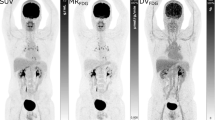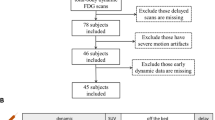Abstract
Objectives
Peristalsis can lead to confusing FDG PET bowel uptake artefacts and potential for recording inaccurate mean standardised uptake value (SUV) measurements in PET-CT scans. Accordingly, we investigate the influence of different SUV normalisations on FDG PET uptake of the bowel and assess which one(s) have least dependence on body size factors in patients with and without the introduction of the anti-peristalsis agent N-butylscopolamine (Buscopan).
Methods
This study consisted of 92 prospective oncology patients, each having a whole body 18F-FDG PET scan. Correlations were investigated between height, weight, glucose, body mass index (bmi), lean body mass (lbm) and body surface area (bsa) with maximum and mean SUV recorded for bowel normalised to weight (SUVw), lbm (SUVlbm), bsa (SUVbsa) and blood glucose corrected versions (SUVwg, SUVlbmg, SUVbsag).
Results
Standardised uptake value normalisations were significantly different between control and Buscopan groups with less variability experienced within individual SUV normalisations by the administration of Buscopan. Mean SUV normalisations accounted for 80% of correlations in the control group and 100% in the Buscopan group. Further, >86% of all correlations across both groups were dominated by mean SUV normalisations of which, about 69% were accounted for by SUVbsa and SUVbsag.
Conclusions
We recommend avoiding mean SUVbsa and individual glucose normalisations especially, mean SUVbsag as these dominated albeit relatively weak correlations with body size factors in control and Buscopan groups. Mean and maximum SUVw and SUVlbm were shown to be independent of any body size parameters investigated in both groups and therefore considered suitable for monitoring FDG PET uptake in the normal bowel for our patient cohort.




Similar content being viewed by others
References
Pandit-Taskar N, Schöder H, Gonen M, Larson SM, Yeung HW. Clinical significance of unexplained abnormal focal FDG uptake in the abdomen during whole-body PET. Am J Roentgenol. 2004;183:1143–7.
Prabhakar H, Sahani D, Fischman A, Mueller PR, Blake MA. Bowel hot spots at PET-CT. Radiographics. 2007;27:145–59.
Stahl A, Weber WA, Avril N, Schwaiger M. Effect of N-butylscopolamine on intestinal uptake of fluorine-18-fluorodeoxyglucose in PET imaging of the abdomen. Nuklearmedizin. 2000;39:241–5.
Emmott J, Sanghera B, Chambers J, Wong WL. The effects of N-butylscopolamine on bowel uptake: an 18F-FDG PET study. Nucl Med Commun. 2008;29:11–6.
Shankar LK, Hoffman JM, Bacharach S, Graham MM, Karp J, Lammertsma AA, et al. Consensus recommendations for the use of 18F-FDG PET as an indicator of therapeutic response in patients in National Cancer Institute trials. J Nucl Med. 2006;47:1059–66.
Yeung HW, Sanches A, Squire OD, Macapinlac HA, Larson SM, Erdi YE. Standardized uptake value in pediatric patients: an investigation to determine the optimum measurement parameter. Eur J Nucl Med Mol Imaging. 2002;29:61–6.
Zasadny KR, Wahl RL. SUV of normal tissues at PET 18-F FDG: variations with body weight and a method for correction. Radiology. 1993;189:847–50.
Paquet N, Albert A, Foidart J, Hustinx R. Within-patient variability of (18)F-FDG: standardized uptake values in normal tissues. J Nucl Med. 2004;45:784–8.
Kim CK, Gupta NC. Dependency of standardized uptake values of fluorine-18 fluorodeoxyglucose on body size: comparison of body surface area correction and lean body mass correction. Nucl Med Commun. 1996;17:890–4.
Sugawara Y, Zasadnyk R, Neuhoff AW, Wahl RL. Reevaluation of the standardized uptake value for FDG: variations with body weight and methods for correction. Radiology. 1999;213:521–5.
Hallett WA, Marsden PK, Cronin BF, O’Doherty MJ. Effect of corrections for blood glucose and body size on [18F]FDG PET standardised uptake values in lung cancer. Eur J Nucl Med. 2001;28:919–22.
Wong CO, Thie J, Parling-Lynch KJ, Zakalik D, Margolis JH, Gaskill M, et al. Glucose-normalized standardized uptake value from 18F-FDG PET in classifying lymphomas. J Nucl Med. 2005;46:1659–63.
Hadi M, Bacharach SL, Whatley M, Libutti SK, Straus SE, Rao VK, et al. Glucose and insulin variations in patients during the time course of a FDG-PET study and implications for the “glucose-corrected” SUV. Nucl Med Biol. 2008;35:441–5.
Keyes JW Jr. SUV: standard uptake or silly useless value? J Nucl Med. 1995;36:1836–9.
Thie J. Understanding the standardized uptake value, its methods, and implications for usage. J Nucl Med. 2004;45:1431–4.
Stahl A, Ott K, Schwaiger M, Weber WA. Comparison of different SUV-based methods for monitoring cytotoxic therapy with FDG PET. Eur J Nucl Med Mol Imaging. 2004;31:1471–9.
Young H, Baum R, Cremerius U, Herholz K, Hoekstra O, Lammertsma AA, et al. Measurement of clinical and subclinical tumour response using [18F]-fluorodeoxyglucose and positron emission tomography: review and 1999 EORTC recommendations. Eur J Cancer. 1995;35:1773–82.
Richard L. Wahl: Why Nearly All PET of Abdominal and Pelvic Cancers Will Be Performed as PET/CT. J Nucl Med. 2004;45(Suppl 1):82S–95S.
Shreeve PD, Anzai YA, Wahl RL. Pitfalls in oncologic diagnosis with FDG PET imaging: physiologic and benign variants. Radiograhics. 1999;19:61–77.
Veit P, Kuhle C, Beyer T, Kuehl H, Herborn CU, Borsch G, et al. Whole body positron emission tomography/computed tomography (PET/CT) tumour staging with integrated PET/CT colonography: technical feasibility and first experiences in patients with colorectal cancer. Gut. 2006;55:68–73.
Author information
Authors and Affiliations
Corresponding author
Rights and permissions
About this article
Cite this article
Sanghera, B., Emmott, J., Wellsted, D. et al. Influence of N-butylscopolamine on SUV in FDG PET of the bowel. Ann Nucl Med 23, 471–478 (2009). https://doi.org/10.1007/s12149-009-0263-3
Received:
Accepted:
Published:
Issue Date:
DOI: https://doi.org/10.1007/s12149-009-0263-3




